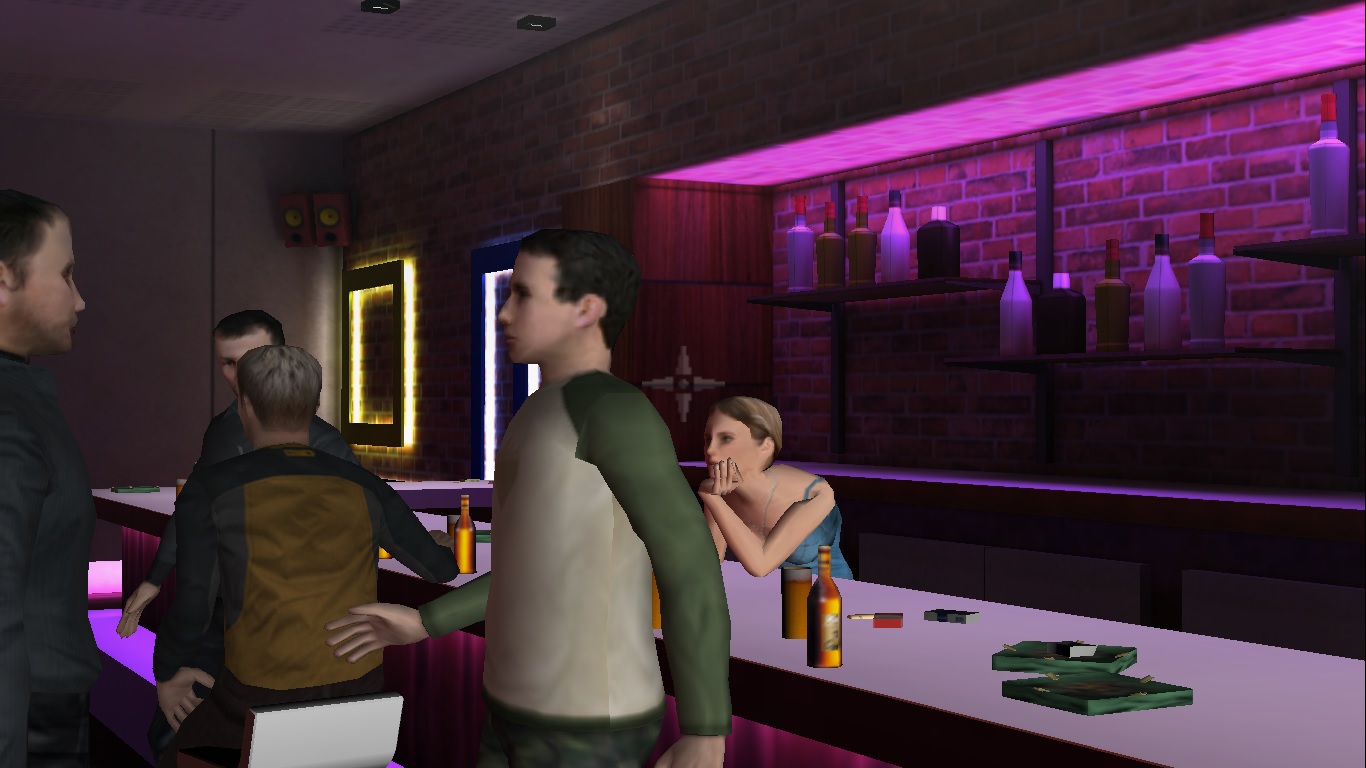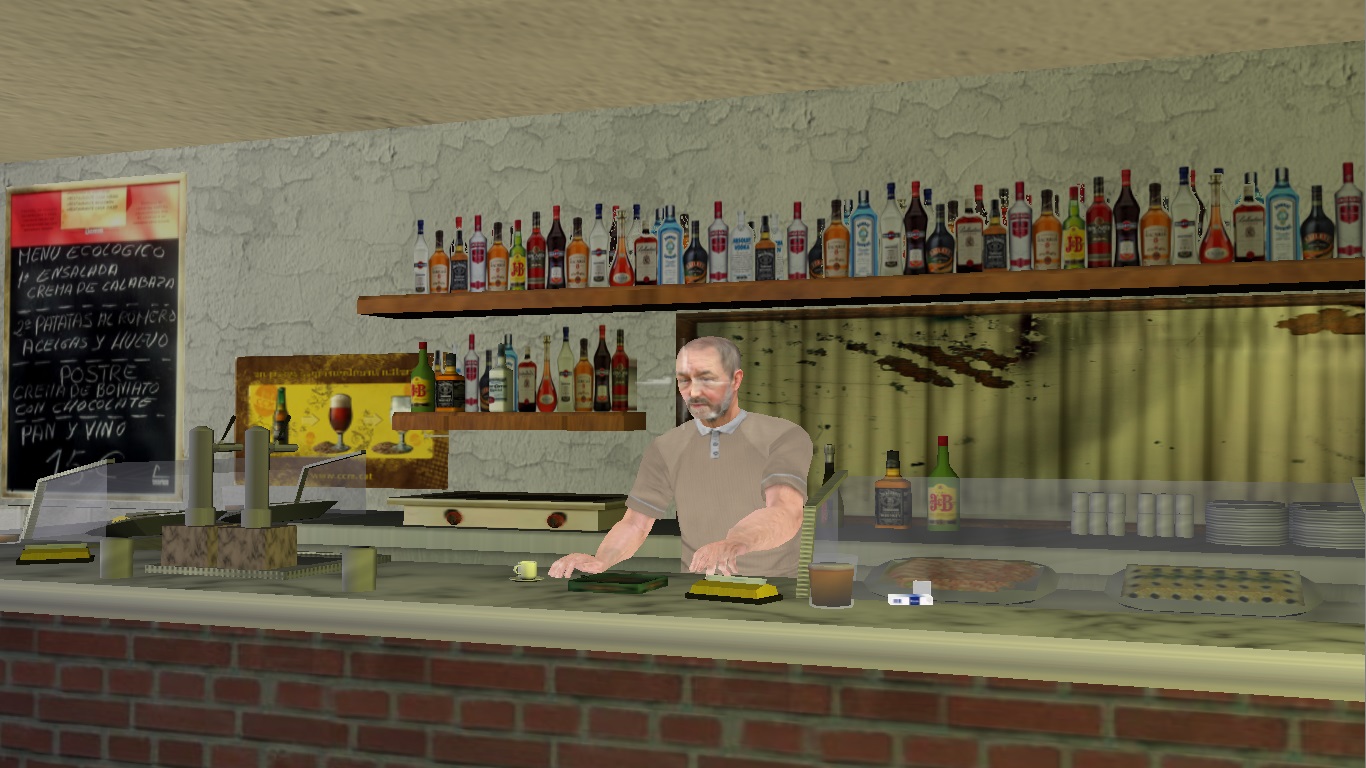Languages / Idiomas / Idiomes

Home > Alcohol Use Disorder (TFM)
Alcohol Use Disorder (TFM)
Virtual Reality: applying new technologies to promote craving reduction among patients with Alcohol Use Disorder
Alumno: Alexandra Ghita
Treball final de: Grau
Director: José Gutiérrez Maldonado
Técnic Informátic:
Colaboradors: Ferran Vilalta Abella, Mario Aglario López
Curso Académico: 2014/2015
Abstract
Background: Craving is understood as an uncontrollable urge to drink alcohol despite consequences. This phenomenon is the underlying mechanism of addiction and repeated relapses. As a result, the current study is concerned with investigating feasible instruments in order to assess and reduce craving for alcohol among patients with Alcohol Use Disorder. Aims: To assess craving with objective and subjective instruments during virtual reality (VR) cue exposure in order to investigate clinical implications of the Virtual Reality Exposure Treatment in alcohol addiction.
Methods: Twenty in/outpatients from Clinic Hospital of Barcelona took part in this study. Pshychophysiological reactivity of the participants was recorded during alcohol-cue exposure and no exposure. Moreover, participants’ subjective cravings were registered pre, during and post each virtual alcohol scenario.
Results: Virtual reality alcohol scenarios determine changes in psychophysiological reactivity and subjective changes in craving; Participants experienced a significant greater subjective craving during virtual alcohol cue exposure compared to no exposure. In addition, craving is independent of the Standard Drink Units/day, days/week drinking pattern or abstinence days before experiment. Likewise, there is a similar craving pattern between men and women.
Conclusions: Virtual Reality Exposure Treatment has a major clinical importance due to its power to trigger objective and subjective craving. Moreover, findings from the current study are consistent with the context-dependency assumption. Participants experience craving only when they are exposed to alcohol stimuli.
1. Aim of the study
A major purpose of the current study is to investigate new technologies that could be applied in the psychological field. Therefore, Virtual Reality is currently explored as a feasible therapeutic tool in order to investigate its effectiveness to reduce alcohol cravings and to prevent relapse among patients with Alcohol Use Disorder. Virtual Reality (VR) is an innovative technology based on virtual exposure that can provide an appropriate method for real life simulation. Virtual exposure represents a physical simulation of realistic environment behavior resulting in interaction and decision-making in a virtual context. The VR aim is to develop coping strategies to confront subjective craving triggered by alcohol cues. With regards to alcohol and drug addiction, VR is mainly used to trigger subjective craving.
Subjective craving is illustrated as an uncontrollable desire or urge to drink alcohol despite consequences. Craving is a pathological appetite to consume alcohol. That craving is the underlying mechanism of addiction, repeated relapses and loss of self-control. Several studies agree that the central role in the maintenance of alcohol addiction over lifetime is played by cravings. Considering previous research, there is an urgent need to investigate VR as a treatment instrument in craving reduction and relapse prevention.
In order to assess the effectiveness of VR among patients with alcoholism, concrete objectives of the current study are focused on the psychophysiological reactivity when patients are exposed to alcohol VR scenarios. Moreover, one would expect that exposure to VR alcohol cues would increment participants’ likelihood to self-report a greater subjective craving compared to no exposure at all. Furthermore, the current study is concerned also whether there are indicators such as the Standard Drink Units (SDU) per day consumed, how many days/week the participant drinks and abstinence days before the experiment. To our best knowledge, this is the first study to use these indicators in order to explore the context-dependency assumption of alcohol craving, which is important to know when it comes to creating a treatment based on virtual reality. And finally, the study aims to investigate whether there are gender differences regarding craving response pattern within virtual scenarios.
2. Virtual Reality scenarios
The VR scenarios created by the Department of Personality, Assessment and Psychological Treatment, University of Barcelona, include specific and relevant alcohol stimuli for the Spanish population. The six virtual environments created by the department contain sufficient cues in order to trigger participants to think/feel they are in a real life situation. These scenarios were chosen to explore which environment triggered more subjective craving in participants with alcoholism in order to tailor further Virtual Reality Exposure Treatment (VRET).
The first scenario was created with the aim to accustom the participants with the novelty of the experiment (e.g. how to move within the environment, how to interact with it, how to report subjective craving in that specific moment on a 0 to 100 scale). Pub was the second scenario. Relevant cues within this environment were alcohol bottles, cigarettes smoke, a dancing floor, a gaming machine, a pool table. The participants’ task was to interact within the environment, to do what would they do if they were in a real situation. In addition, participants let investigators know how many drinks and the type of drink they would consume in a similar situation. The third scenario was the midday house. This environment was built to explore whether this intimate circumstance would elicit subjective craving in participants. The relevant cues within this scenario were a kitchen with all the utensils, a bedroom, a living room with a big table, a couch, a big screen TV. This environment was created on daylight, around lunch time with a meal on the table and three kinds of beverages: wine, beer and water. The participants could fill their glasses as many times they wanted. The investigators recorded the number of drinks and the type of beverage the participants preferred. The fourth environment was the midnight house, the same environment as the previous one, but on midnight time. The scenario was similar with a quiet night at home, with a classical movie on screen, with cigarettes smoke and a bottle of whisky on the table. The participants had the choice to fill their glass with whisky as many times they wanted while watching the movie. This scenario was important in order to determine if this circumstance of spending time alone at home with an alcohol bottle would trigger more subjective craving than other environments. The fifth scenario was a Spanish bar with tapas bar, lots of varied alcohol bottles, small tables, football match on a TV screen and a gaming machine. The participants could choose one of the next beverages at the bar: beer, tequila or water. All consumed drinks were registered by the investigators. And the last scenario was represented by a restaurant. The restaurant contained specific elements of a common restaurant like tables, bar, food, drinks. The important element within this environment was the interaction between the participants and the virtual friends, sitting on a table, eating, smoking and drinking either coffee, either alcohol. This was a common situation when people go out and spend time with their friends. The researchers also registered alcohol preferences of the participants.
3. Methods
3.1. Participants
In this study, 20 patients (n=20) were recruited from the Clinic Hospital of Barcelona, Department of Addictive Behaviors. The participants were included in the study on basis of their signed written consent. This study was approved by the Ethical Committee of the Clinic Hospital of Barcelona, Spain. The participants were men (40 %) and women (60%) with the average age of M=51, SD=12, 61, range 30-72 years. With respect to the diagnostic, 45% (n=9) of the participants were diagnosed with moderate Alcohol Use Disorder (4-5 symptoms) and 55% (n=11) of the participants were diagnosed with severe Alcohol Use Disorder (6-7 symptoms) according to The Diagnostic and Statistical Manual of Mental Disorders (DSM–5; American Psychiatric Association, 2013).
3.2. Materials
VR scenarios. A 3D computer, 3D glasses and audio headsets were used to create similar real life situations in VR. The six VR scenarios were: training session, a pub, midday and midnight house, a bar and a restaurant.
Psychophysiological reactivity. We explored the psychophysiological reactivity with a I-330-C2 + 6 Channel Polygraph. The polygraph registered the skin conductance (SC), heart rate (HR) and skin temperature level across the six environments.
Subjective craving. First, the subjective craving was explored before the VR task with the Multidimensional Alcohol Craving Scale (MACS) (Serecigni, Garcia, Cirac, Albet, Pociello, Gonzalez & Gil, 2004). The MACS is a Spanish scale with the aim to assess the severity of the alcohol craving experienced during participants’ last week on a Likert scale from 1 “Strongly disagree” to 5 “Strongly agree” (Serecigni, Luquero Vived, Llosa, Burguete & Cardus Moya, 2006). Ultimately, the outcomes of the MACS resulted into three categories: desire to drink score, behavioral disinhibition score and the global score.
Second, the subjective craving was explored through the self-reported subjective craving scale during VR exposure. This scale appeared every 150 seconds, and the participants before, during and after the VR alcohol exposure reported their alcohol craving on a scale from 0 to 100, where 0 was the absence of craving and 100 indicated intense craving.
3.3. Procedure
Participants were attached to electrodes to their right and left wrists in order to register their skin conductance and heart rate reactivity and small electrodes were attached on their index finger, middle finger and ring finger to register their skin temperature. For 20 minutes, the participants were kindly asked to remain as calm as they could in order to register their baseline psychophysiological reactivity. This part of the protocol was important because it showed differences in the psychophysiological response in a resting state compared to an alcohol- related state.
Preceding the baseline registration, the participants were exposed to the six different environments. Each of these scenarios lasted approximately 5 minutes, with 5 minutes break between the scenarios. A major purpose of these pauses was to return to the baseline rate, thus helping participants to get out of one alcohol scenario and to prepare them to enter in a new one. In this way, there was no interference between the craving responses within different VR scenarios. Fig. 1 represents a concise illustration of the VR task procedure:

Fig.1. Virtual Reality experimental procedure.
The participants were visually and auditory connected to real life simulations in a dark room within Clinic Hospital of Barcelona. During exposure, every 150 seconds (pre, during and post each scenario), a visual analog scale from 0 to 100 (self-reported subjective craving scale) appeared on screen asking participants to report their subjective craving for alcohol in that specific moment.
3.4. Data analysis.
One-Way Repeated Measures ANalysis Of VAriance (ANOVA) using SPSS Statistics Version 20.0 for within subjects design was used to analyze the data. The means of the psychophysiological reactivity (SC, HR and Temp) during baseline measurement and VR alcohol exposure were compared to identify whether participants experienced arousal changes when they were exposed to alcohol cues compared to a resting state. One-Way Repeated Measures ANOVA was used to explore subjective craving on the analog scale from 0 to 100 at three different levels (pre, during and post VR exposure). A series of Pearson r correlations were used to explore whether craving is determined by the number of SDU/day, days/week drinking pattern and abstinence period before the VR experiment. In order to respond the question whether there are significant gender differences, One-Way ANOVA for between subjects design was utilized to compare the means of the “desire to drink” factor from MACS results and the subjective craving experienced during VR exposure.
4. Results and discussion
The results of the present study show remarkable clinical implications of virtual reality framework in alcohol addiction treatment. First, the effectiveness of VR scenarios was demonstrated by generating changes in psychophysiological reactivity, which was determined by relevant alcohol cues. That is, participants experienced an increased arousal while VR exposure. There is a clear effect between measurement of skin conductance level at baseline timepoint and the skin conductance reactivity during VR exposure timepoints (F(1,900, 26,599) = 3,76, p<.05) (Fig.2). Post hoc tests using the Bonferroni correction indicated that VR scenarios pub and midnight house statistically differed from the baseline measurement (SEM= .55, p< .05). This strong effect indicates that the pub and the midnight house are the scenarios that most craving generate in individuals with alcoholism. In addition, these two scenarios indicate treatment implications due to its importance to train individuals with alcohol addiction to cope with these common real situations (pub, house). Conversely, no strong effect was found with respect to the heart rate reactivity between baseline and VR exposure timepoints F(1,633, 31,032) = 0.76, p = .44. We assume that this pattern in heart rate reactivity is due to the small clinical sample. However, there is a significant difference in skin temperature between baseline and VR exposure timepoints (F(1,394, 26,485) = 4,68, p = .029). It is observed a gradual decrease in temperature once participants advance across the five VR alcohol scenarios.
The psychophysiological response pattern in alcohol addiction has a major importance in the clinical setting. On one hand, changes in psychophysiological reactivity determine that the five VR scenarios contain strong, relevant alcohol stimuli in virtual environments in order to generate these physiological changes. On the other hand, a gradual decrease in temperature indicates that exposure to strong alcohol cues may diminish body responses when prolonged exposure. This pattern response is consistent with the skin conductance pattern response in which can be observed a tendency towards habituation as it gradually decreases in its intensity. Therefore, VR exposure can be seen as a therapeutic tool to reduce subjective craving when alcohol-cue exposure due to its gradual decrease in psychophysiological reactivity. These findings have a crucial importance in terms of developing treatment in terms of craving reduction and relapse prevention.
Furthermore, the findings from our current study show that participants experienced increased subjective craving during VR alcohol exposure compared to no exposure F(4,168, 79, 188) = 2,51, p = .046. This result pattern sustains the context-dependency assumption of alcohol craving. The context-specific phenomenon is also sustained by the findings from our fourth, fifth and sixth hypotheses. That is, craving is independent of how many SDU the participants drink per day (r = -.004, p = .985). This means that the quantity of consumed alcohol does not reflect an increased craving during cue-exposure. Moreover, the number/week the participants drink does not influence elicitation of craving (pub, r = .072, p = .763; midday house, r = .388, p = .091; midnight house, r = .133, p = .576; bar, r = .055, p = .819; restaurant, r = .284, p = .224). The more days per week the participants drink do not determine a greater craving while VR exposure. Furthermore, abstinence days before experiment do not predict an increased or decreased craving during VR exposure (pub, r = -.047, p = .843; midday house, r = .049, p = .838; midnight house, r = .099, p = .677; bar, r = .005, p = .982; restaurant, r = .095, p = .691). The fact that participants stopped drinking/continued drinking few days before experiment, does not influence in any aspect how they experience craving during VR exposure. These results pattern show that craving is not determined by indicators such as SDU/day, days/week drinking pattern or abstinence days. To our best knowledge, this is the first study to use these indicators in order to investigate their link with subjective cravings. To conclude, craving is triggered only when alcohol cues are present and this assumption has a major clinical importance in terms of creating virtual and tailored treatments for patients with alcoholism. Finally, our last predition indicates that there are no significant gender differences regarding craving pattern response. Therefore, men and women experience similar psychophysiological reactivity when they are exposed and not exposed to alcohol cues and similar subjective craving responses while alcohol-cue exposure.
Through the current study, VR has proven its effectiveness in provoking subjective craving in patients with alcoholism. This craving elicitation was explored with objective and subjective tools such as the polygraph or the self-reported craving scale. VR has a major clinical importance due to its power to trigger craving and due to its safety to develop adaptive responses to high risk situations. Because alcohol cravings are context-dependent, Virtual Reality Exposure Treatment (VRET) can be a promising instrument to reduce urges to drink. However, empirical evidence exists from Fleming et al. (2009), and treatment based on VR can extinguish craving for alcohol. Alcoholic participants, although vulnerable due to the high arousal caused by the presence of alcohol cues, can be assisted to self-build coping strategies and to gradually overcome from easy to more complex alcohol-related scenarios. As a result, Virtual Reality Exposure Treatment can be a therapeutic tool with clinical implications for patients with alcohol use disorder.




______________________________
Services:
Follow us on University of Barcelona's social networks:
Member of Two Campuses of International
Excellence HR Excellence in Research
More information:
© Universitat de Barcelona